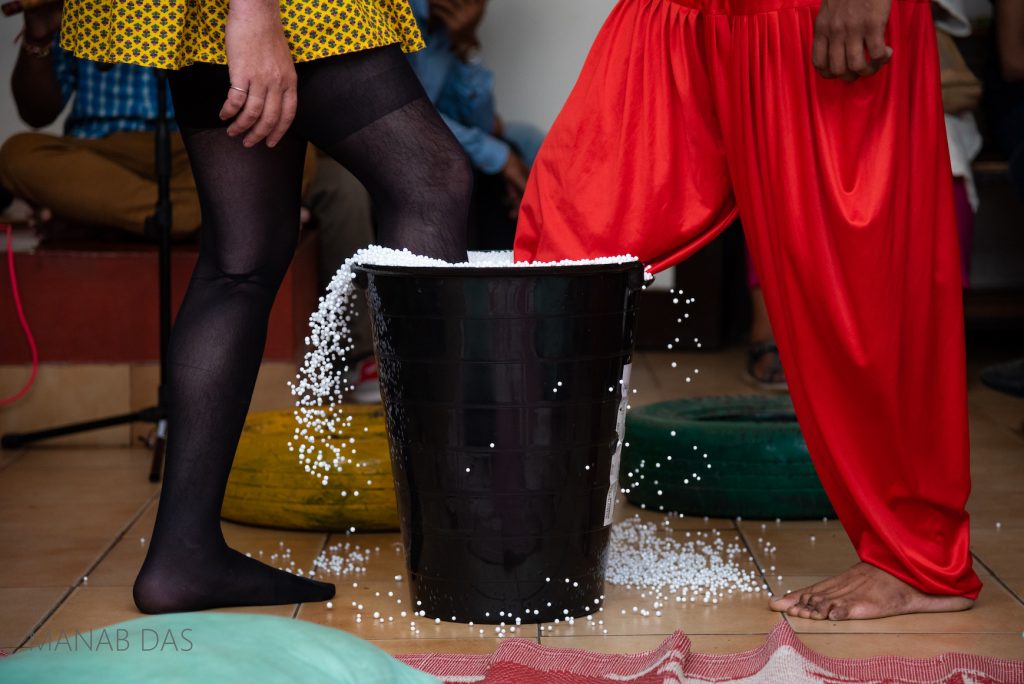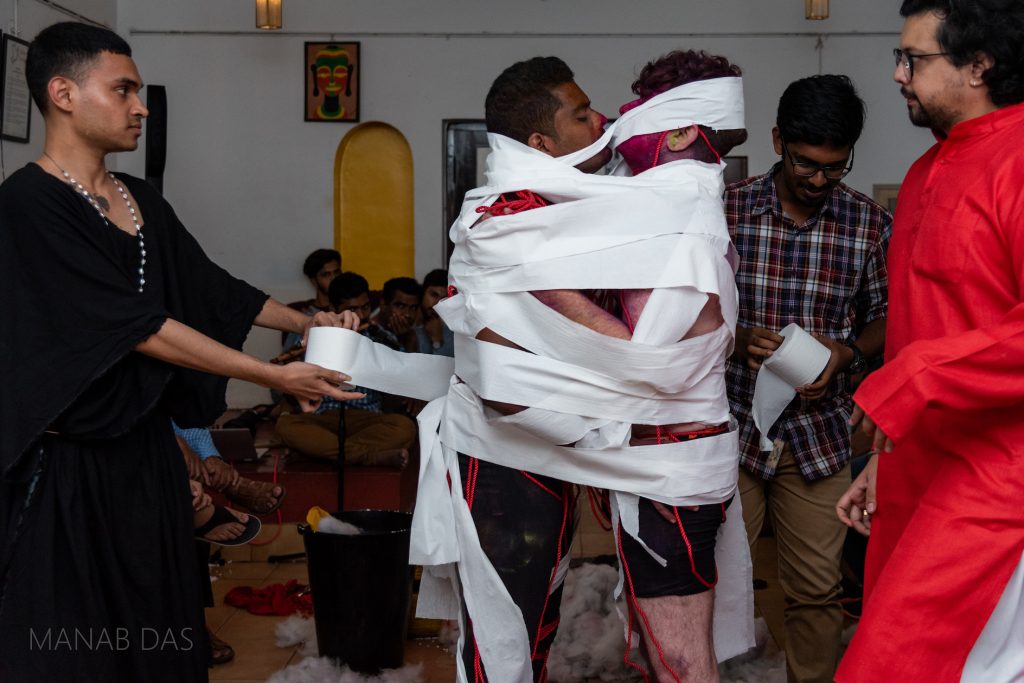Hyderabad witnessed one of its first interactive performance called “Four Play” on the evening of 29th September, at its much-celebrated open space cultural centre Lamakaan. The presentation was an interactive performance art curated and presented by Expressionist dancer and performance artist Patruni Chidananda Sastry and Theater Artist Sajiv Palasa.
“Four Play”, as the name suggests, is a bold, thought-provoking performance act for raising awareness on sexual education, body and sexual desire and a sharp outcry against non-recognition of same-sex marriages. The performers called themselves Exhibits. Exhibit one (Patruni Sastry) was dressed in drag. without any makeup and outpoured masculinity to bring in a sharp fluidity of both feminine, masculine and transvestite representation, representing the feminine in a marriage setup. Exhibit two (Sajiv Palasa) was more about being himself, poured masculinity without a gender-bend. They were to play four games – games of lust, ego, greed and anger.
The performance started when both the exhibits were standing in inverted tiers (showing partnership of marriage as two tires of a vehicle) and started shouting “I am superior” in turns. They then slowly moved towards a white drawing board where they marked it as Game 1.
Game 1 was a fluxed representation of traditional games played by the couple in a south Indian family called Okhli with a twist. Both the exhibits needed to find a Handcuff in a bucket full of beans, first with legs, then heads and hands. The person who won was called superior and the other removed his upper garment.

The next game had both of them walk on a mat handcuffed together and walking randomly within the interface of the mat and intermittently folding it to half of its length. When they reached the minimum fold, they had to fight with Pillows (an intimate game played by a couple) and destroy the pillow into cotton. This depicted a representation of the sacred 7 steps, but was not limited to just 7. The folding of the mat was symbolic, showcasing how same-sex couples/ straight couples are forced not to exhibit their feelings outside the boundaries of the wall and restrict themselves within confined spaces to avoid moral policing. Sajiv won this game and Sastry ended up in two-piece costume. An intense picture was put in front of the crowd where he stood wearing an inner garment of a woman (resisting the moral policing of what women must wear).

Game three proceeded with the couple playing Talambralu (a south Indian marriage ritual) with rainbow colours symbolizing pride. The movements became more subtle and sensual, depicting the importance of touching, eye contact, connectivity within two people and educating the aspects of exploration of sexuality. The fading dynamics of superior vs inferior, dominant versus submissive and masculine vs feminine was depicted in the act of pouring colours one after the other from each other’s head; claiming equality of their sexual instinct and promise to walk along.

The final game was “BRAHMA MUDI”. Representing the Mangalasutra, however, was a long rope that dangled between the couple showcasing the long battle the same-sex couple must fight to get marital acceptance in this country. This long rope was wrapped by both the exhibits while they walked towards each other and become one. Both were cocooned into the rope and shared a kiss of love to showcase the superiority of love over everything. At this moment, the audience started stepping up with the roll of tissue papers and wrapped it around the couple to showcase the taboo associated with showcasing affection in public spaces. The tissue was used to send a strong message about discrimination against same-sex couples, public display of affection, right to express and take a strong stand against moral policing.

The performance ended with the artists addressing the crowd. A participant asked: “Why did you choose these games, was its intent to mock the marriage system?” Patruni replied, “This was to symbolize the nonacceptance of these rituals for same-sex couples by the society and as a strong statement that this is how the same-sex couples visualize these ceremonies when the society closes the door.”

The background flute music by Pawan from the Nations Rock Beat enthralled the audience, who asked curious questions from the artists. The event was first of its kind in Hyderabad, with maximum participation from the audience. The event ended with Patruni thanking the Lamakaan operations, Mobbera foundation and Manab Das for their contributions in making this a successful event.
- Film Kuch Sapney Apne Celebrates Diversity and Family Acceptance, and Stars Parents and LGBTQ+ Members in Cast - February 25, 2025
- Chennai Rainbow Film Festival 2025 Celebrates Diversity and Artistic Excellence - February 24, 2025
- #UNLABEL #BORN COLOURLESS: Absolut Mixers Calls for a World Without Labels - January 20, 2025

